Polyphaga
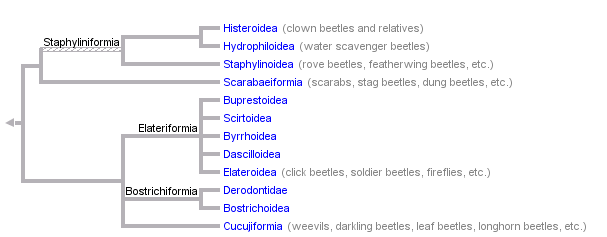


This tree diagram shows the relationships between several groups of organisms.
The root of the current tree connects the organisms featured in this tree to their containing group and the rest of the Tree of Life. The basal branching point in the tree represents the ancestor of the other groups in the tree. This ancestor diversified over time into several descendent subgroups, which are represented as internal nodes and terminal taxa to the right.

You can click on the root to travel down the Tree of Life all the way to the root of all Life, and you can click on the names of descendent subgroups to travel up the Tree of Life all the way to individual species.
For more information on ToL tree formatting, please see Interpreting the Tree or Classification. To learn more about phylogenetic trees, please visit our Phylogenetic Biology pages.
close boxIntroduction
The suborder Polyphaga contains the majority of beetles, with about 300,000 described species.
Among the commonly encountered polyphagans are the rove beetles (Staphylinoidea), scarabs and stag beetles (Scarabaeoidea), metallic wood-boring beetles (Buprestoidea), click beetles and fireflies (Elateroidea), as well as fungus beetles, grain beetles, ladybird beetles, darkling beetles, blister beetles, longhorn beetles, leaf beetles, and weevils (all Cucujiformia).
Aquatic lineages have evolved several times within Polyphaga. The largest groups are found within Hydrophiloidea and Byrrhoidea.
Characteristics
Polyphagan beetles do not have the pleuron of the prothorax externally visible; instead, remnants of the propleuron are present internally as a "cryptopleuron" (Hlavac 1972, 1975; Lawrence and Newton, 1982). Because the lack of the pleuron in the external body wall, at most one suture (that between the notum and the sternum) is visible in the prothorax in polyphagans. In members of other suborders, two sutures (the sternopleural and notopleural) are often externally visible (unless secondary fusion between the sclerites obfuscates the sutures, as in the case of Micromalthus).
Female polyphagan beetles have telotrophic ovarioles, a derived condition within beetles.
References
Arnett, R.H. 1973. The Beetles of the United States (A manual for identification). The American Entomological Institute, Ann Arbor, Michigan.
Arnold'di, L.V., V.V. Zherikhin, L.M. Nikritin, and A.G. Ponomarenko (eds.). 1977. Mezozoiskie Zhestkokrylye. Akademiya Nauk SSSR, Trudy Paleontologicheskogo Instituta, Vol. 161. Nauka Publishers, Moscow.
Arnold'di, L.V., V.V. Zherikhin, L.M. Nikritin, and A.G. Ponomarenko (eds.). 1992. Mesozoic Coleoptera. Smithsonian Institution Libraries, Washington, D.C. (English translation of Arnold'di et al., 1977.)
Boving, A.G. and F.C. Craighead. 1931. An illustrated synopsis of the principal larval forms of the order Coleoptera. The Brooklyn Entomological Society, Brooklyn, N.Y.
Caterino, M. S., T. Hunt and A. P. Vogler. 2005. On the constitution and phylogeny of Staphyliniformia (Insecta: Coleoptera). Molecular Phylogenetics and Evolution 34(3):655-672.
Crowson, R.A. 1955. The natural classification of the families of Coleoptera. N. Lloyd, London.
Crowson, R.A. 1960. The phylogeny of Coleoptera. Annual Review of Entomology, 5:111-134.
Crowson, R.A. 1981. The biology of the Coleoptera. Academic Press, London.
Hlavac, T.F. 1972. The prothorax of Coleoptera: origin, major features of variation. Psyche 79(3): 123-149.
Hlavac, T.F. 1975. The prothorax of Coleoptera: (Except Bostrichiformia - Cucujiformia). Bulletin of the Museum of Comparative Zoology 147(4): 137-183.
Kukalov?-Peck, J. and J.F. Lawrence. 1993. Evolution of the hind wing in Coleoptera. The Canadian Entomologist, 125:181-258.
Lawrence, J.F., and Britton, E.B. 1994. Australian Beetles. Melbourne University Press, Carlton, Victoria.
Lawrence, J.F., and A.F. Newton, Jr. 1982. Evolution and classification of beetles. Annual Review of Ecology and Systematics, 13:261-290.
Lawrence, J.F., and A.F. Newton, Jr. 1995. Families and subfamilies of Coleoptera (with selected genera, notes, references and data on family-group names). Pp 779-1006 in Pakaluk and Slipinski (1995).
Lawrence, J.F., S.A. Slipinski, and J. Pakaluk. 1995. From Latreille to Crowson: a history of the higher-level classification of beetles. Pp 87-154 in Pakaluk and Slipinski (1995).
Pakaluk, J. and S.A. Slipinski (eds.) 1995. Biology, Phylogeny, and Classification of Coleoptera. Papers Celebrating the 80th Birthday of Roy A. Crowson. Muzeum i Instytut Zoologii PAN, Warszawa.
Title Illustrations

| Scientific Name | Popillia japonica |
|---|---|
| Location | USA IL Champaign Co.: Champaign, 40.120 N 88.275 W 230m |
| Source | Popillia japonica - Japanese Beetle |
| Copyright |
© Alex Wild

|
| Scientific Name | Chrysobothris chryseola |
|---|---|
| Location | Pinelands Natural Area, St. Lucie County, Florida, USA |
| Specimen Condition | Live Specimen |
| Source | Chrysobothris chryseola |
| Source Collection | Flickr |
| Image Use |
 This media file is licensed under the Creative Commons Attribution-NonCommercial-ShareAlike License - Version 2.0. This media file is licensed under the Creative Commons Attribution-NonCommercial-ShareAlike License - Version 2.0.
|
| Copyright | © 2006 Sean McCann |
| Scientific Name | Epicauta pardalis |
|---|---|
| Location | USA AZ Pima Co.: 16 km ESE Green Valley, 31º46.907'N 110º50.583'W 1200m |
| Specimen Condition | Live Specimen |
| Source | Epicauta pardalis - blister beetle |
| Copyright |
© Alex Wild

|
About This Page
Correspondence regarding this page should be directed to David R. Maddison at
Page copyright © 1995 David R. Maddison
 Page: Tree of Life
Polyphaga.
The TEXT of this page is licensed under the
Creative Commons Attribution License - Version 3.0. Note that images and other media
featured on this page are each governed by their own license, and they may or may not be available
for reuse. Click on an image or a media link to access the media data window, which provides the
relevant licensing information. For the general terms and conditions of ToL material reuse and
redistribution, please see the Tree of Life Copyright
Policies.
Page: Tree of Life
Polyphaga.
The TEXT of this page is licensed under the
Creative Commons Attribution License - Version 3.0. Note that images and other media
featured on this page are each governed by their own license, and they may or may not be available
for reuse. Click on an image or a media link to access the media data window, which provides the
relevant licensing information. For the general terms and conditions of ToL material reuse and
redistribution, please see the Tree of Life Copyright
Policies.
Citing this page:
Tree of Life Web Project. 1995. Polyphaga. Version 01 January 1995 (temporary). http://tolweb.org/Polyphaga/8870/1995.01.01 in The Tree of Life Web Project, http://tolweb.org/




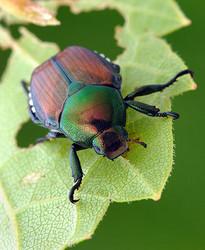
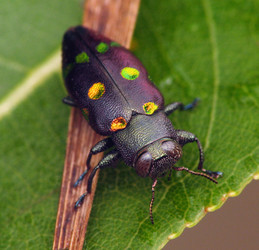
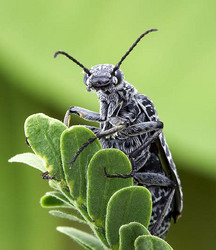

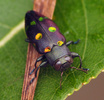


 Go to quick links
Go to quick search
Go to navigation for this section of the ToL site
Go to detailed links for the ToL site
Go to quick links
Go to quick search
Go to navigation for this section of the ToL site
Go to detailed links for the ToL site